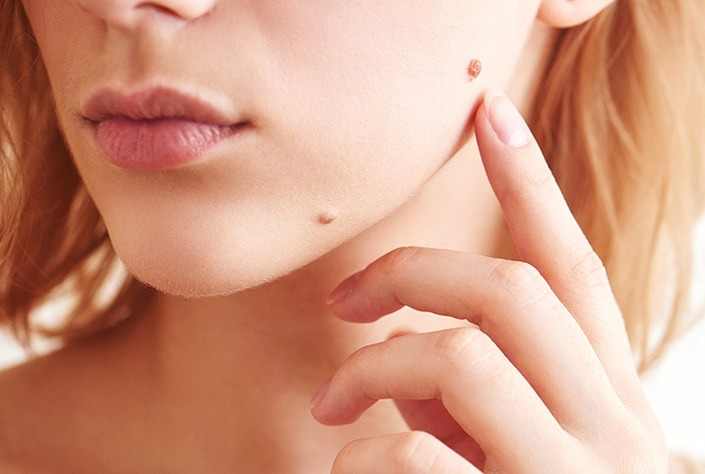

Skin tags are unsightly & uncomfortable skin growths that affect thousands of New Zealanders. And though they’re generally harmless, they can still be bothersome and make you self-conscious in your own skin.
But you don’t have to feel self-conscious anymore. With several effective methods, removing skin tags has never been easier. We’ll explore each of these methods in detail, breaking down the benefits, risks, and procedure itself. With all of the information, you can make the best decision on how to get rid of skin tags for you & your body.
Skin tags are small, harmless growths that can appear anywhere on the body, but are most common on the neck, underarms, and eyelids. They can also occur within body folds like under the breasts or in the groyne area.
The most common cause of skin tags is skin rubbing against clothing, jewellery or other skin.
They usually have a flesh-coloured or slightly darker appearance and can range in size from a few millimetres to several centimetres. And though they are typically painless, skin tags can become irritated if they constantly rub against clothing or jewellery. They’re more common in individuals who are overweight or have diabetes.
Skin tags can be removed using a variety of methods. We’ve described each of these methods in more depth below, but it’s important to note that you should not perform any of these procedures on your own. Always seek the help of a medical professional like one of our trained cosmetic clinicians.
At Transform Clinic, we use Surgitron to remove skin tags, the latest radiosurgery technology that cuts away abnormal skin tissue with precision. High-frequency radio waves are administered directly to the area, removing the damaged tissue without damaging the healthy tissue.
Before we begin the Surgitron procedure, we’ll treat the area with local anaesthetic, making it painless. There is very little risk of complications and compared to the other methods, is least likely to cause scarring. The cosmetic outcome is always better than cutting out the surrounding skin.
In the days following the procedure, you must keep the wound clean to prevent infections. But in just a few days, your skin will heal and look normal. Among cosmetic clinicians and dermatologists, the Surgitron is considered to be the most effective skin tag removal technique.
Before touching the skin tag or making any cuts, the healthcare provider will clean the area to reduce the likelihood of infection. Then, they’ll apply a topical anaesthetic to numb the skin and limit your discomfort during the procedure; the area will become numb within minutes. Depending on the size & location of the skin tag, the provider will use a scalpel, scissors, or surgical blade to cut off the skin tag.
They’ll cut as close to the base of the tag as possible, which may cause some bleeding. This is normal. As with any small cut, the bleeding will be stopped with pressure and a bandage. Keep the area covered with a bandage and protect it from infections by applying antibiotic ointment 1-2x per day for the next several days. It should heal within 3-5 days and scarring will be minimal, if at all present.
Cryotherapy is a method of removing skin tags (and warts) that involves the use of liquid nitrogen. After a local anaesthetic is applied, your clinician will apply liquid nitrogen directly to the skin tag via spray canister or cotton swab. This freezes the skin tag’s growth and the surrounding skin tissue, causing it to fall off. Depending on the size & location of the tag, it may fall off within just a few hours or take 1-2 days.
The procedure is relatively painless, though you may feel a cold, tingling sensation while the liquid nitrogen is applied. For most skin tags, this method requires just one visit, though larger growths may require multiple visits or a separate removal method altogether. Once the skin tag falls off, cover the area with a bandage for a few days until the area heals.
Electrocautery is another common skin tag removal method, where the growth is burned off by heating it with a light electrical current issued via metal probe. The procedure takes just 30 minutes, killing the abnormal tissue with extreme heat. As with the other methods, you’ll receive a local, topical anaesthetic; however it’s worth noting that you may feel a slight tingling sensation when the metal probe touches the skin tag.
Your skin should heal within 2-3 weeks with minimal scarring, as the heat will discolour the affected tissue. Over time, the scarring should fade and blend in with the surrounding skin colour.
Can you safely remove skin tags yourself?
No, it is generally not safe to remove skin tags yourself. Improper removal may cause bleeding, infection, and/or scarring, which could lead to expensive, out-of-pocket medical bills.
What is the fastest way to get rid of a skin tag?
The fastest way to get rid of a skin tag depends on the size, location, and number of skin tags you have. And though a home remedy or DIY method may seem like the fastest option to get rid of a skin tag, these methods are rarely that simple, causing complications down the road. With the help of a medical professional, the Surgitron technique is the fastest & most effective way to get rid of skin tags.
